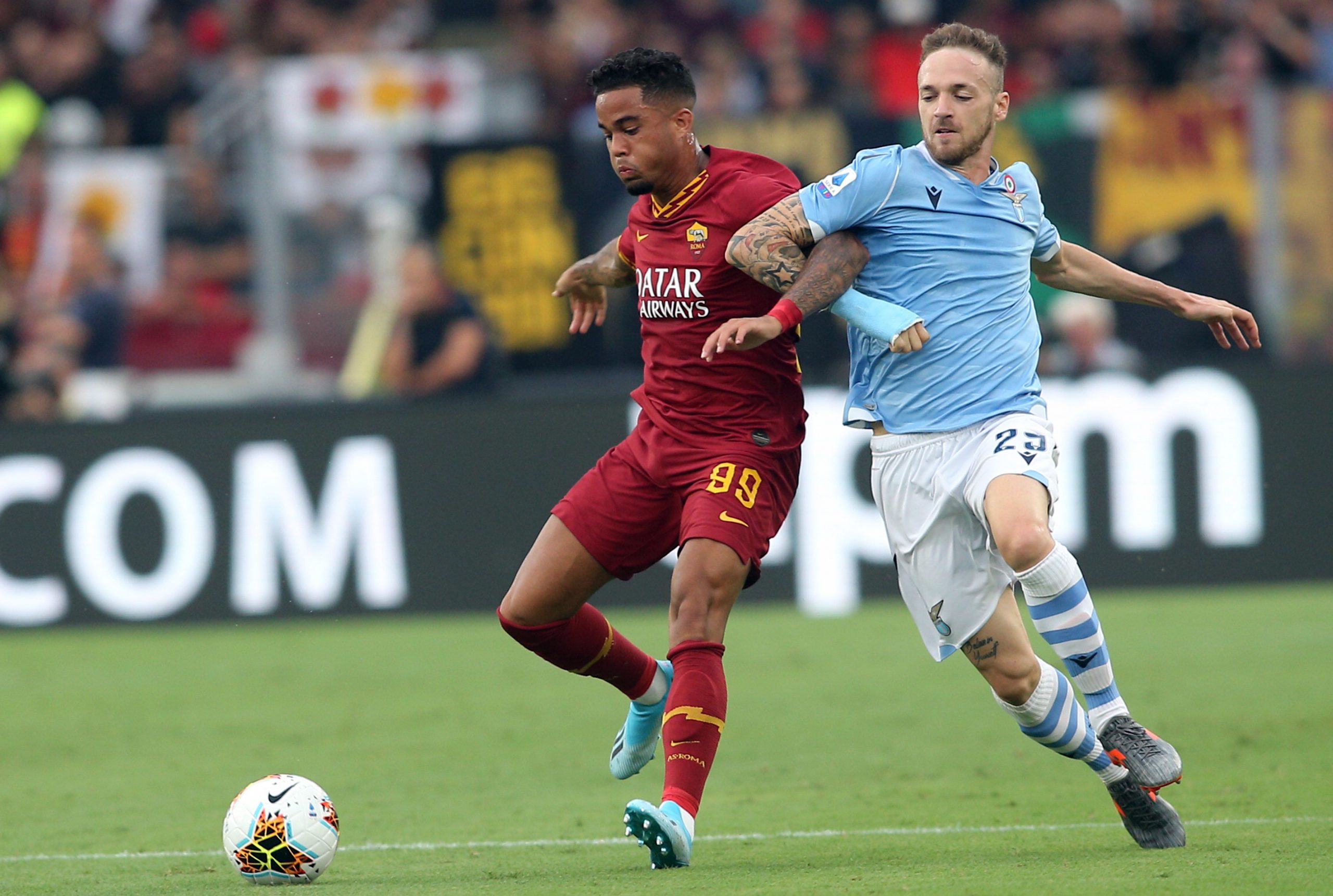Dawn is still breaking over the new Serie A season, but the Italian league has already given a lot of excitement and crackling matches to the fans, who will not be particularly happy with the arrival of the international break. In the first two match days, 68 goals were scored, six more than last season and 11 more than in 2017-18, a figure that had not been reached for almost 70 years. The last edition of Serie A to start with more goals after the first two days was that of 1950-51, when the total amount was 77. In recent seasons, we have seen an increase in offensive production, with increasingly proactive teams leading to higher scoring matches. So, it's no wonder, that out of the 20 games played so far this season, eight have seen at least four goals scored. The schedule has contributed to making the start of the season even more fascinating, as the second match-day has straight away gifted us Juventus - Napoli and the "Derby della Capitale", Lazio - Roma. Both matches were fought until the last minute that, and, if you have not already done so, I strongly recommend giving them a watch.
Juventus 4-3 Napoli: Same players, new roles
It's still too early to establish if Napoli can finally overcome the reigning champions, but the Turin game gave us our first data point, with Juventus able to beat Ancelotti’s team in a breathtaking match. After taking a three goal lead Juventus collapsed, before Kalidou Koulibaly's own goal in added time of the second half, put the Bianconeri back in the lead, setting the final result at 4-3 and giving Juventus an early 3-point advantage in the table. In a summer of change for Juventus, not much has changed in terms of personnel on the pitch. Maurizio Sarri replaced Massimiliano Allegri at Juventus, but of all the new signings, Matthijs De Ligt was the only one in the starting eleven. Due to the same bout of pneumonia that denied him the chance to lead the team from the bench in the Parma match, the new Bianconeri manager was forced to give up his place to his assistant coach Martusciello. If Sarri was barely visible, hidden by the windows of the skybox of Allianz Stadium, the impact of his principles of play on his team was well evident. In the team's win against Parma their opponents defended low, without contesting Juventus possession, but Napoli began the game immediately trying to cause difficulties to the build-up play of the hosts. In this scenario, Sarri's players' pressing-resistance emerged. Ancelotti fielded on paper a 4-2-3-1 but during the defensive phase he pushed Fabián Ruiz near Dries Mertens to press the Juventus center-backs, with Piotr Zielinski who in turn pushed higher up the pitch to mark Miralem Pjanić, the holding midfielder of the Bianconeri. Juventus, lined up with a 4-3-3, proved to be a team capable of playing the ball with composure, even attracting Napoli’s pressure on purpose, in an effective attempt to make the play progress. 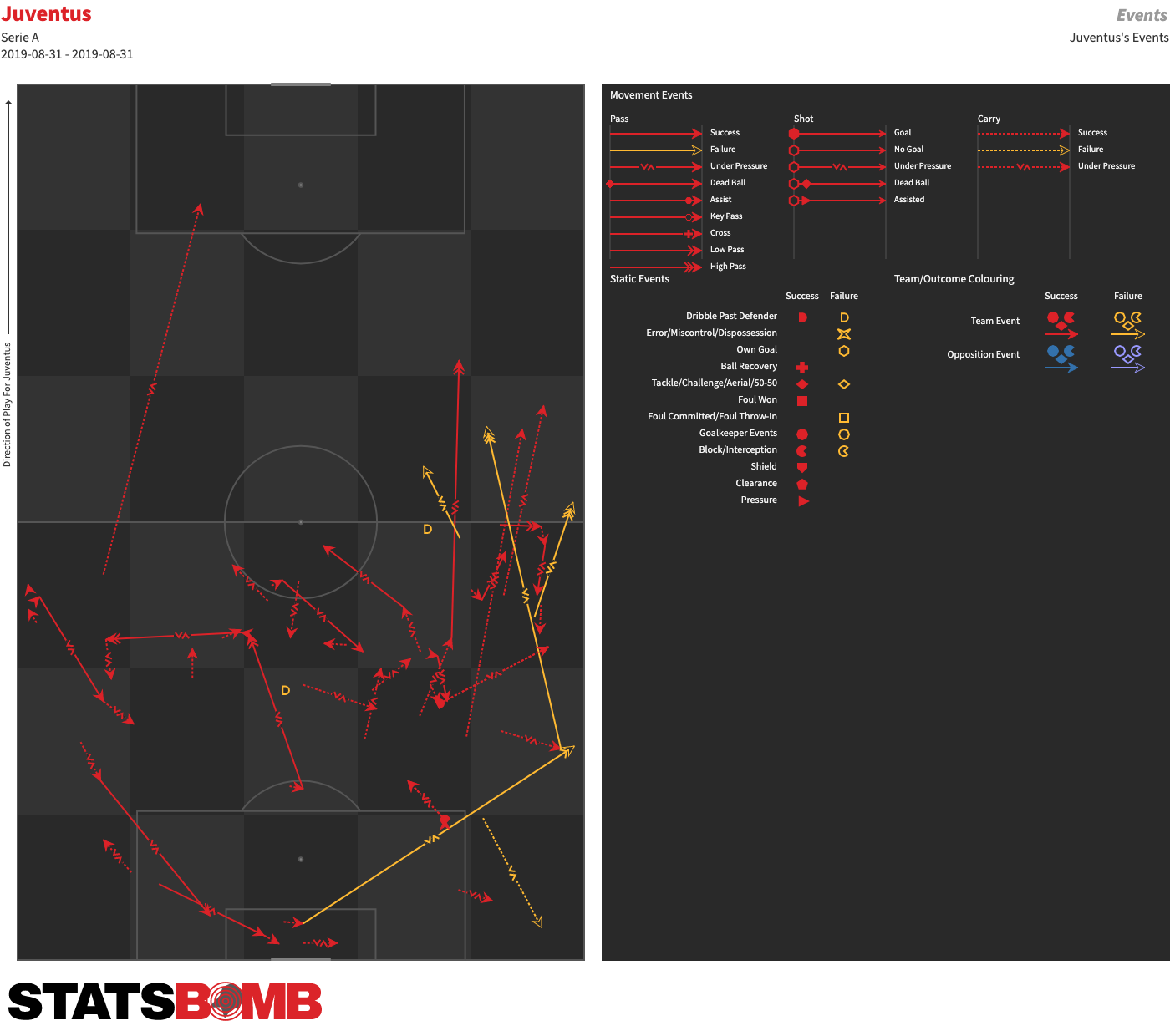 The chart of Juventus pressured passes, dribbles and carries from the first half, shows how the hosts were consistently able to overcome the opposing press in their own half, a feat that allowed them to manipulate Napoli's defensive shape and opening up spaces to attack. Because of Napoli's pressing strategy, which in light of Zielinski advanced position on Pjanić, forced Allan to guard the midfield alone, the involvement of Juve no. 8s Sami Khedira and Blaise Matuidi in relatively wide zones, was one of the keys to the match, especially in the first half.
The chart of Juventus pressured passes, dribbles and carries from the first half, shows how the hosts were consistently able to overcome the opposing press in their own half, a feat that allowed them to manipulate Napoli's defensive shape and opening up spaces to attack. Because of Napoli's pressing strategy, which in light of Zielinski advanced position on Pjanić, forced Allan to guard the midfield alone, the involvement of Juve no. 8s Sami Khedira and Blaise Matuidi in relatively wide zones, was one of the keys to the match, especially in the first half. 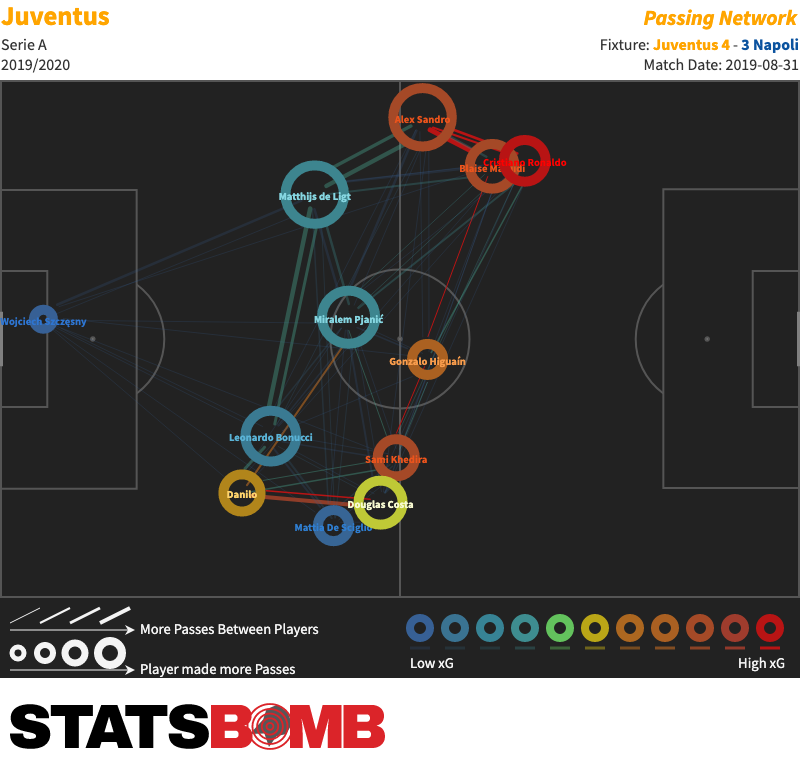 The use of no. 8s was one of the most interesting aspects of the game. Sarri showed that Khedira and Matuidi, two players who seemd to be on the transfer chopping block all summer, can be used in roles functional to his football and completely different to those in which Allegri used them. Khedira, who with Allegri sometimes even acted as an auxiliary striker, was used in lower areas to put his intelligence at the disposal of the team in order to advance the play. Higuaín's goal to make the scoreline 2-0 originated from this type of play, which saw Khedira first drag Allan out of position, then pass the ball to Danilo before receiving it back in the space left vacant by the Brazilian, for what was perhaps the single most important play for the goal, as pictured in the chart below.
The use of no. 8s was one of the most interesting aspects of the game. Sarri showed that Khedira and Matuidi, two players who seemd to be on the transfer chopping block all summer, can be used in roles functional to his football and completely different to those in which Allegri used them. Khedira, who with Allegri sometimes even acted as an auxiliary striker, was used in lower areas to put his intelligence at the disposal of the team in order to advance the play. Higuaín's goal to make the scoreline 2-0 originated from this type of play, which saw Khedira first drag Allan out of position, then pass the ball to Danilo before receiving it back in the space left vacant by the Brazilian, for what was perhaps the single most important play for the goal, as pictured in the chart below. 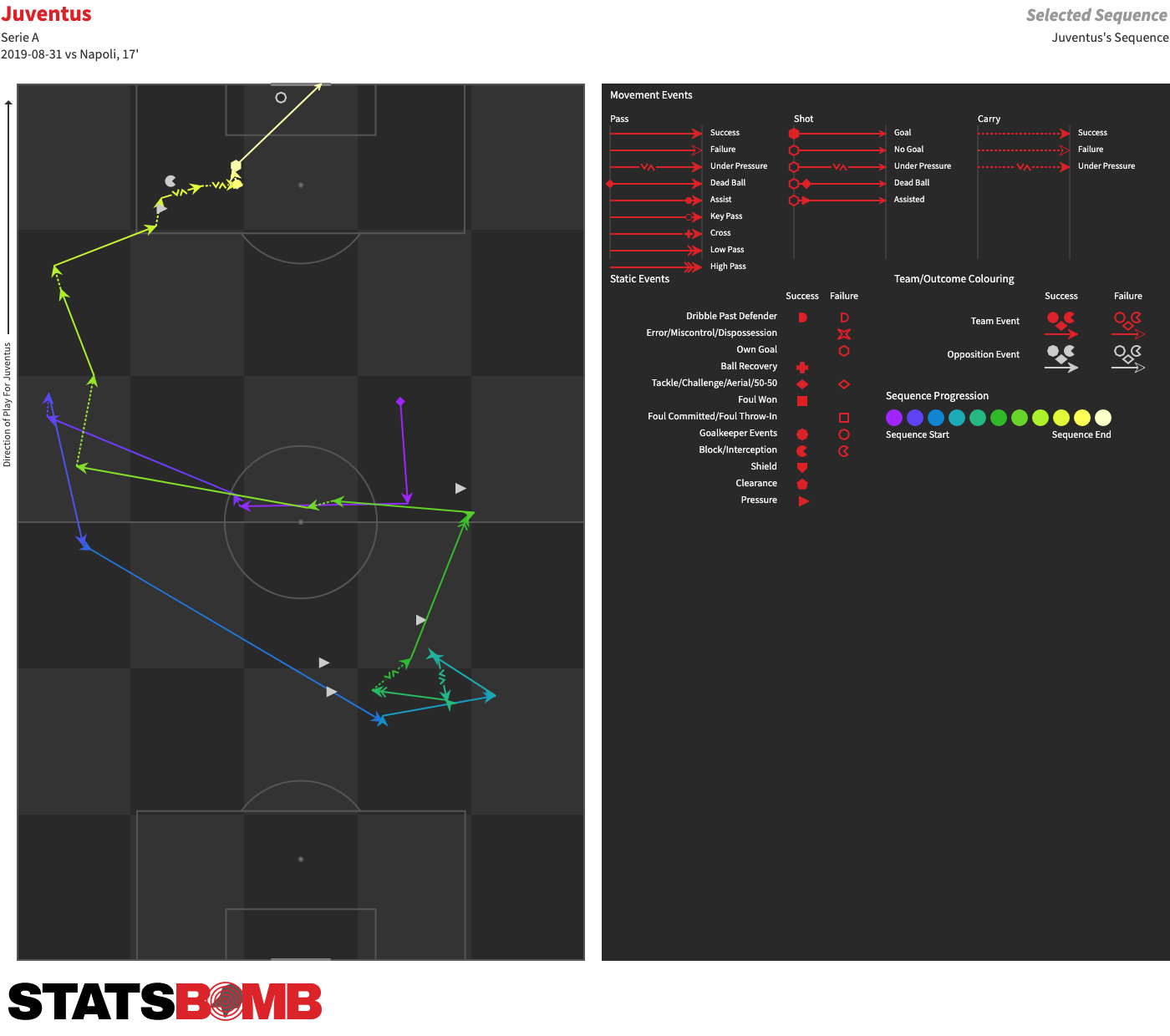 Matuidi, on the other hand, was employed as a wider weapon, creating 3 chances and above all floating in space to the right of Allan, where he created interesting game dynamics together with Danilo and Cristiano Ronaldo, who were often freed in higher zones by his receptions behind Napoli lines. Below, you can see a chart of all passes received by Matuidi, noticing how most of them are over the midfield line and on the left half of the pitch, the zone Zielinski vacated to press Pjanić.
Matuidi, on the other hand, was employed as a wider weapon, creating 3 chances and above all floating in space to the right of Allan, where he created interesting game dynamics together with Danilo and Cristiano Ronaldo, who were often freed in higher zones by his receptions behind Napoli lines. Below, you can see a chart of all passes received by Matuidi, noticing how most of them are over the midfield line and on the left half of the pitch, the zone Zielinski vacated to press Pjanić. 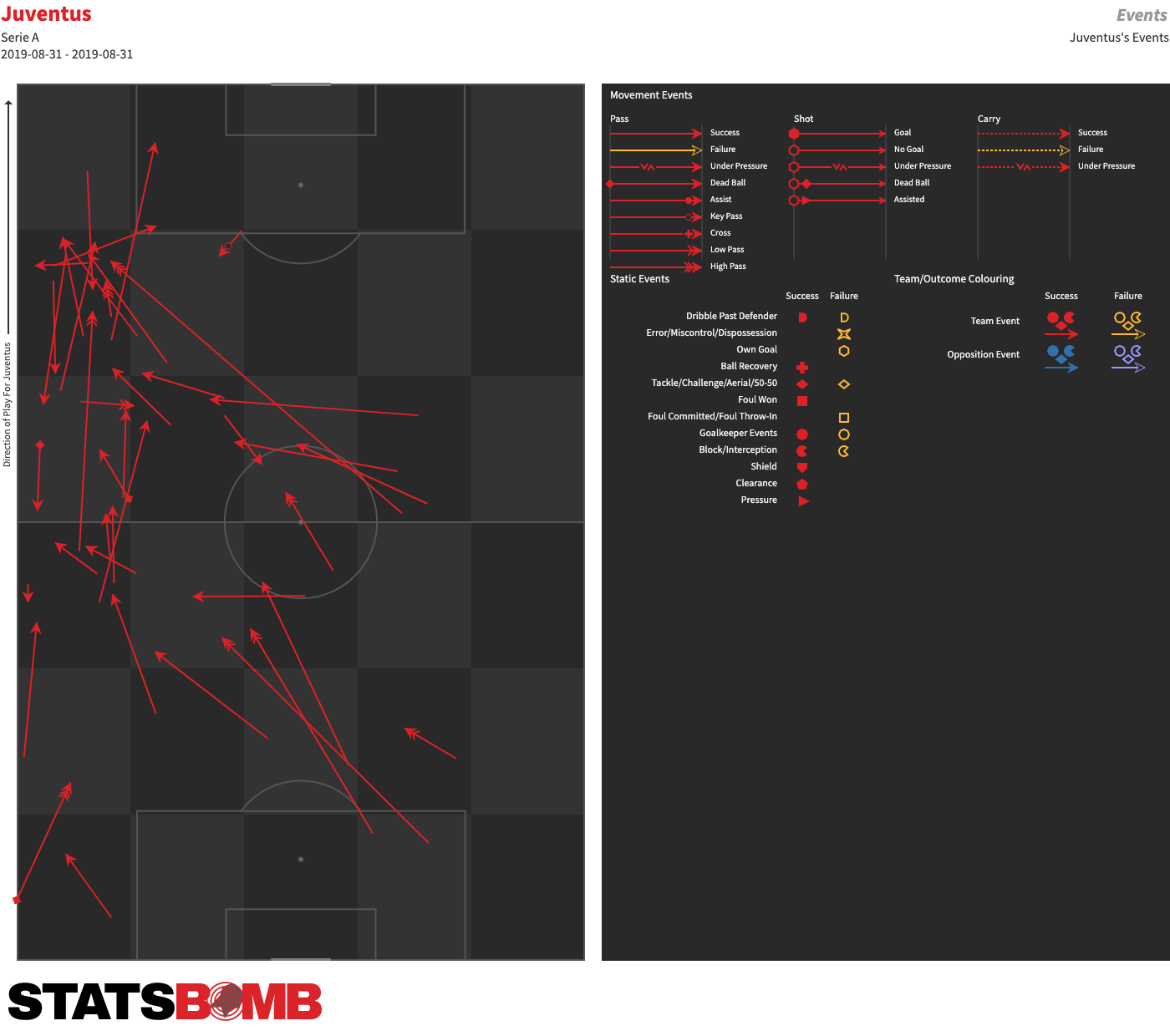 He received 10 passes from Alex Sandro (the most frequent combination for his team), passes which ultimately led to shots with an xG value of 0.57, a team-high for the game. When off-the-ball, Juventus reshaped in a 4-4-2, with the French midfielder playing on the left wing and carrying his and Ronaldo’s defensive load. His involvement in the offensive phase did not prevent him from being the usual hammer in pressing, recording 34 pressures, surpassing all his teammates (Pjanić was second with 20) and four ball recoveries in the opposing half. Other than becoming an instant classic, Juventus - Napoli is the first game that in a way definitively clearly marks the transition from Allegri to Sarri. Against his former team, the Tuscan coach has shown the influence he can have on his players, using two players who were two “fedelissimi” of Allegri in roles completely different from those in which we were used to seeing them play. Of course, the defensive phase remains to be fixed, since costly individual errors they put the result of the match in question, but he was chosen to reshape the team and it will be appealing to witness further evolutions as the season progresses. On the other hand, Napoli's start to the season is worrying from a defensive point of view. While it's true that they have conceded six non-penalty goals but just 2.29 non-penalty xG, 31 shots against after two games, is far from ideal. There's still plenty of time to improve, but Ancelotti’s side is already three points down in the standings.
He received 10 passes from Alex Sandro (the most frequent combination for his team), passes which ultimately led to shots with an xG value of 0.57, a team-high for the game. When off-the-ball, Juventus reshaped in a 4-4-2, with the French midfielder playing on the left wing and carrying his and Ronaldo’s defensive load. His involvement in the offensive phase did not prevent him from being the usual hammer in pressing, recording 34 pressures, surpassing all his teammates (Pjanić was second with 20) and four ball recoveries in the opposing half. Other than becoming an instant classic, Juventus - Napoli is the first game that in a way definitively clearly marks the transition from Allegri to Sarri. Against his former team, the Tuscan coach has shown the influence he can have on his players, using two players who were two “fedelissimi” of Allegri in roles completely different from those in which we were used to seeing them play. Of course, the defensive phase remains to be fixed, since costly individual errors they put the result of the match in question, but he was chosen to reshape the team and it will be appealing to witness further evolutions as the season progresses. On the other hand, Napoli's start to the season is worrying from a defensive point of view. While it's true that they have conceded six non-penalty goals but just 2.29 non-penalty xG, 31 shots against after two games, is far from ideal. There's still plenty of time to improve, but Ancelotti’s side is already three points down in the standings.
Lazio 1-1 Roma
For football enthusiasts, it was an extraordinary game, the fans were delighted, it was a great show. It was an exciting first Derby, so many strong feelings are difficult to handle. We saw a tribute to football.
If I haven't already convinced you to check out the derby between Lazio and Roma, then let the words of Paulo Fonseca, the new Giallorossi coach do it. In fact, the Derby, despite the result of 1-1, was a particularly enjoyable match, but unfortunately for the Portuguese coach, the credit was mainly due to Simone Inzaghi’s Lazio. In the second part of last season, the Biancocelesti’s manager began experimenting with a new system, which allows him, while maintaining the 3-5-2 as the basic formation, to deploy all his best offensive players. That is now his favored selection, and he deployed it in the Derby as well. Lucas Leiva, who is living a second youth in Italy, was the holding midfielder, Sergej Milinković-Savić and Luis Alberto acted as number 8s and last season’s super-sub Joaquín Correa supported Immobile in the attack. So far so good, since Lazio lead the league in expected goals after two matches (4.10 xG). 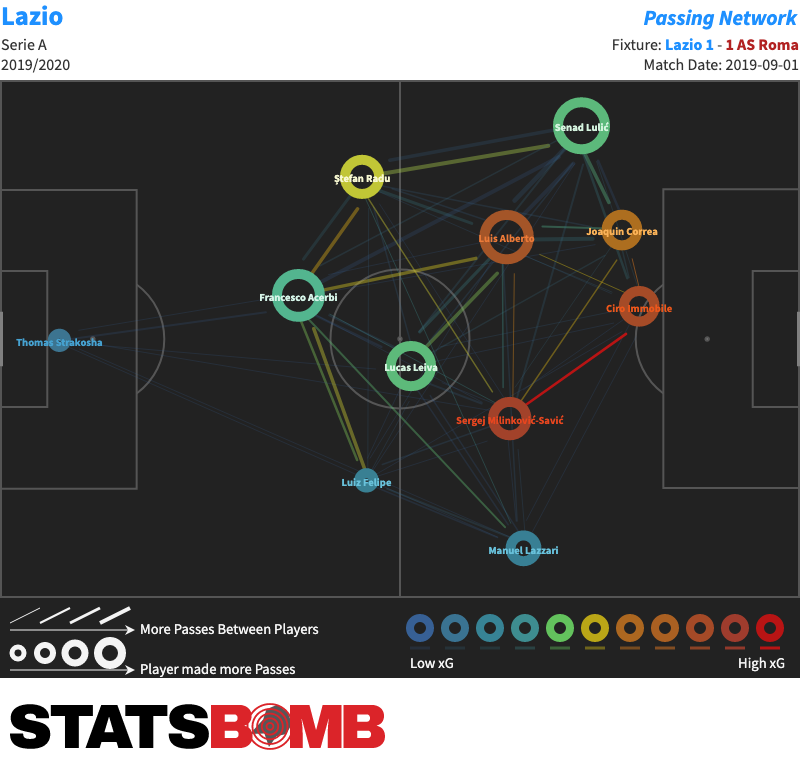 As you can see from the passing network above, Inzaghi used Senad Lulić and new purchase Manuel Lazzari as wingbacks, keeping them always very high and wide. This served to disorganize the compact 4-4-2 that Fonseca used in the defensive phase, attracting Cengiz Ünder and Justin Kluivert to the wing, freeing space in the danger zone for his four offensive players. This strategy was particularly effective on the left-hand side of Lazio’s attack, where Luis Alberto combined often with Lulić and Correa, while also Milinković-Savić moved to the inside, leaving Lazzari free to act in isolation. Below you can see the Biancocelesti’s passes, dribbles and carries who finished in the opposing last third.
As you can see from the passing network above, Inzaghi used Senad Lulić and new purchase Manuel Lazzari as wingbacks, keeping them always very high and wide. This served to disorganize the compact 4-4-2 that Fonseca used in the defensive phase, attracting Cengiz Ünder and Justin Kluivert to the wing, freeing space in the danger zone for his four offensive players. This strategy was particularly effective on the left-hand side of Lazio’s attack, where Luis Alberto combined often with Lulić and Correa, while also Milinković-Savić moved to the inside, leaving Lazzari free to act in isolation. Below you can see the Biancocelesti’s passes, dribbles and carries who finished in the opposing last third. 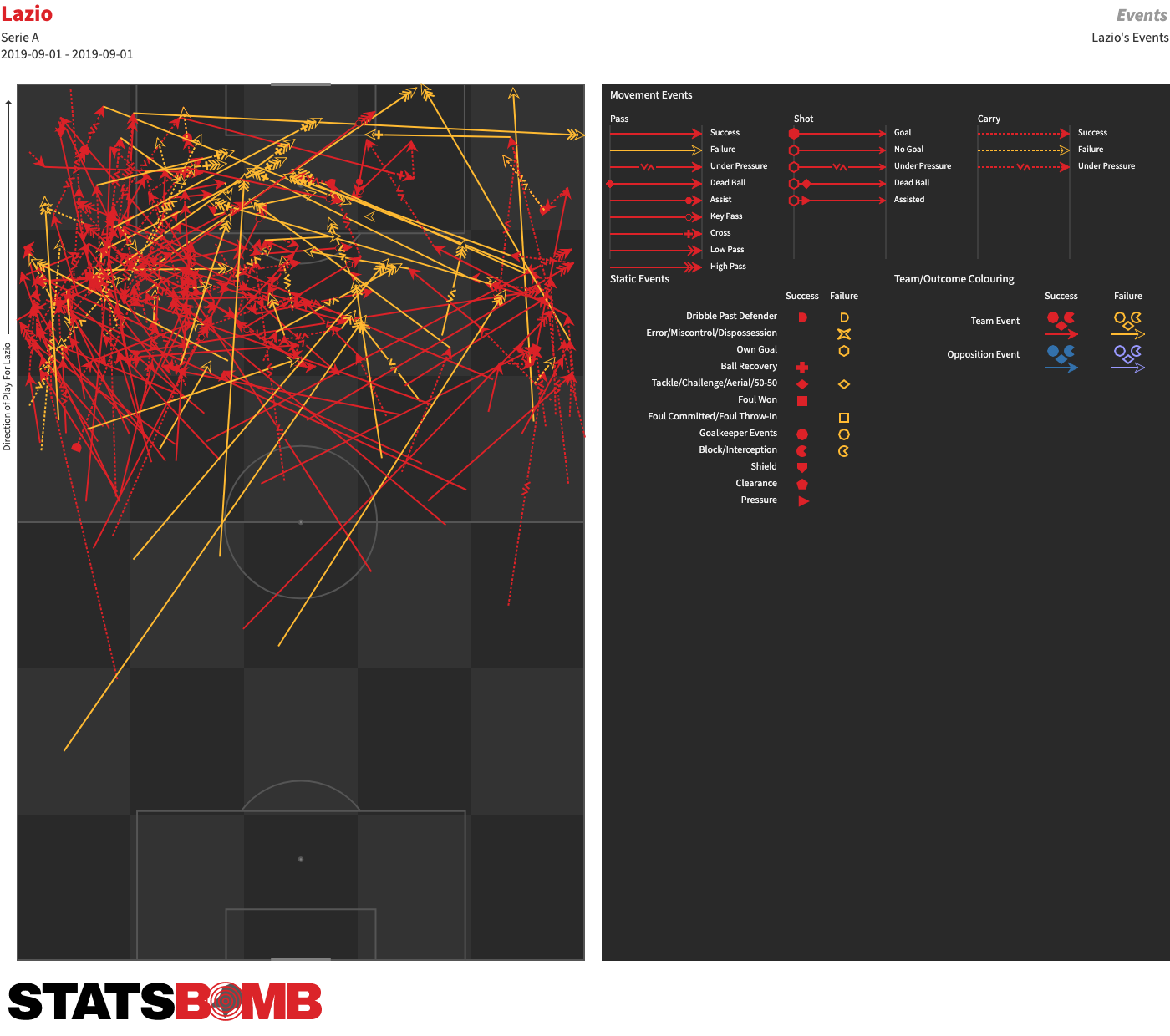 Another of Lazio’s offensive weapons were switches of play from one side of the pitch to the other, that helped move Roma's lines horizontally and caused imbalances in their defensive shape.
Another of Lazio’s offensive weapons were switches of play from one side of the pitch to the other, that helped move Roma's lines horizontally and caused imbalances in their defensive shape. 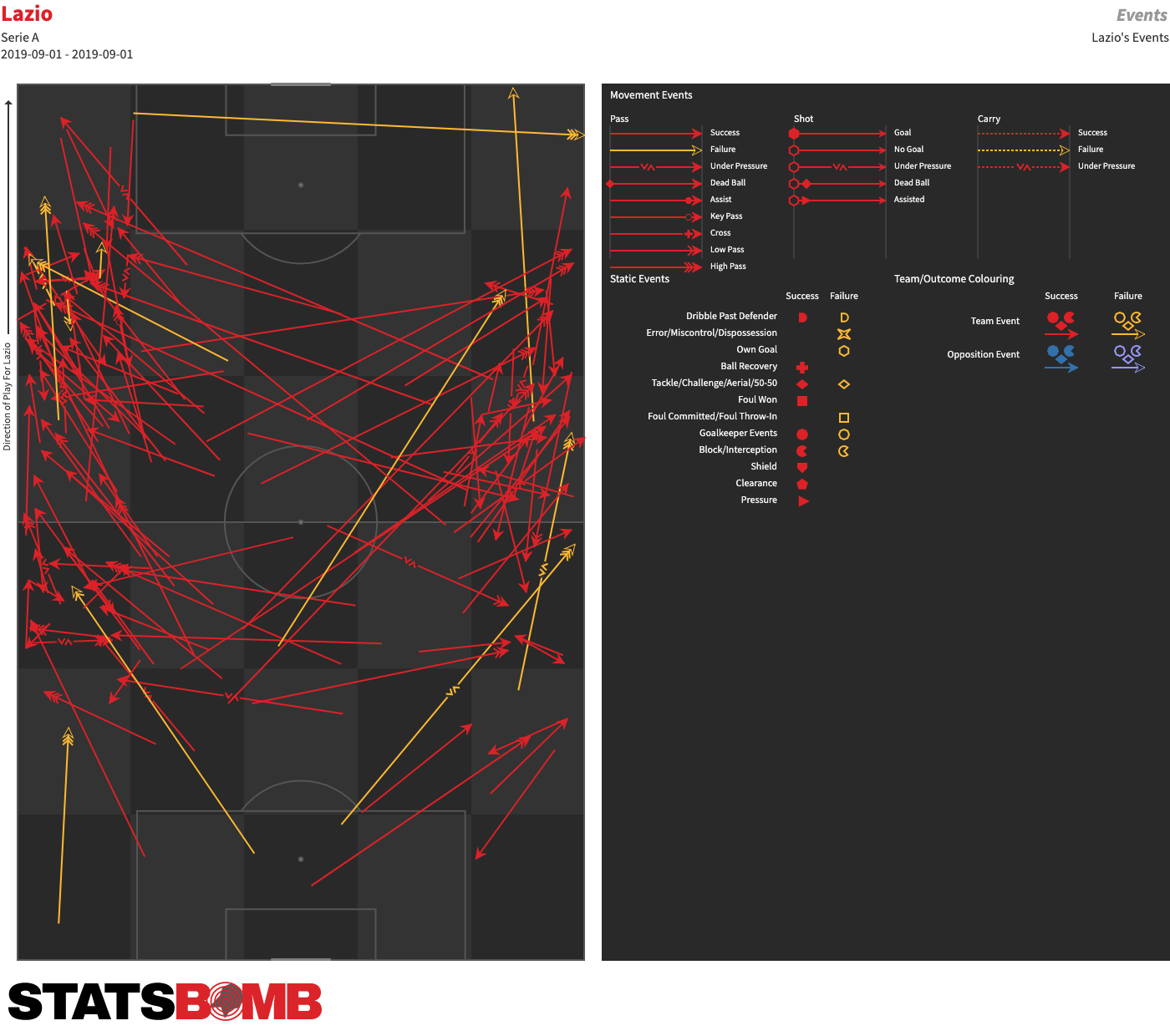 All in all, the Giallorossi seemed far from having assimilated Fonseca’s ideas, who in his first ever “Derby della Capitale” opted for a conservative approach. Roma defended quite deep and decided not to press high, leaving just Dzeko and Zaniolo upfront pressing against Leiva and the three Inzaghi’s center-backs.
All in all, the Giallorossi seemed far from having assimilated Fonseca’s ideas, who in his first ever “Derby della Capitale” opted for a conservative approach. Roma defended quite deep and decided not to press high, leaving just Dzeko and Zaniolo upfront pressing against Leiva and the three Inzaghi’s center-backs. 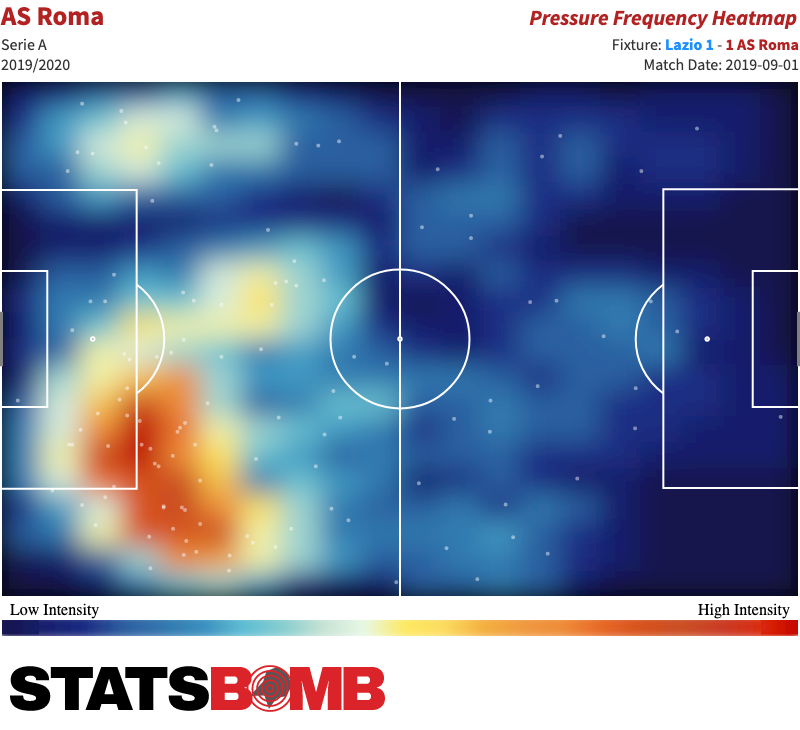 In attack, they generated just 0.42 xG from ten open-play shots, with just three shots inside Lazio’s box. Even worse, they completed just 2 passes inside their opponents’ box (Lazio completed 14), with one that was a very wide cross and the other a pass to Pastore, who controlled the ball on the left side, with his feet just inside the line of the 18 yards box. Despite all this, Roma were able to take the lead thanks to Aleksander Kolarov's penalty, while Lazio was repeatedly stopped by the woodwork. The final count for Lazio was four woodwork hits, while Roma had two. No Serie A match of the 21st century counted more. Lazio can do no more than complain about not winning such an important match after showing such a clear superiority over their rivals. The Biancocelesti had 22 shots and generated 1.74 xG, including 0.5 xG in the last 27 minutes, in which Roma had no shots. Serie A is only at the beginning and these two teams in particular have accustomed us to considerable swings in their performance during the course of season, but this new offensive setup makes Lazio one of this season's must-watch teams, while Fonseca’s Roma still has many challenges to address. Header image courtesy of the Press Association
In attack, they generated just 0.42 xG from ten open-play shots, with just three shots inside Lazio’s box. Even worse, they completed just 2 passes inside their opponents’ box (Lazio completed 14), with one that was a very wide cross and the other a pass to Pastore, who controlled the ball on the left side, with his feet just inside the line of the 18 yards box. Despite all this, Roma were able to take the lead thanks to Aleksander Kolarov's penalty, while Lazio was repeatedly stopped by the woodwork. The final count for Lazio was four woodwork hits, while Roma had two. No Serie A match of the 21st century counted more. Lazio can do no more than complain about not winning such an important match after showing such a clear superiority over their rivals. The Biancocelesti had 22 shots and generated 1.74 xG, including 0.5 xG in the last 27 minutes, in which Roma had no shots. Serie A is only at the beginning and these two teams in particular have accustomed us to considerable swings in their performance during the course of season, but this new offensive setup makes Lazio one of this season's must-watch teams, while Fonseca’s Roma still has many challenges to address. Header image courtesy of the Press Association
